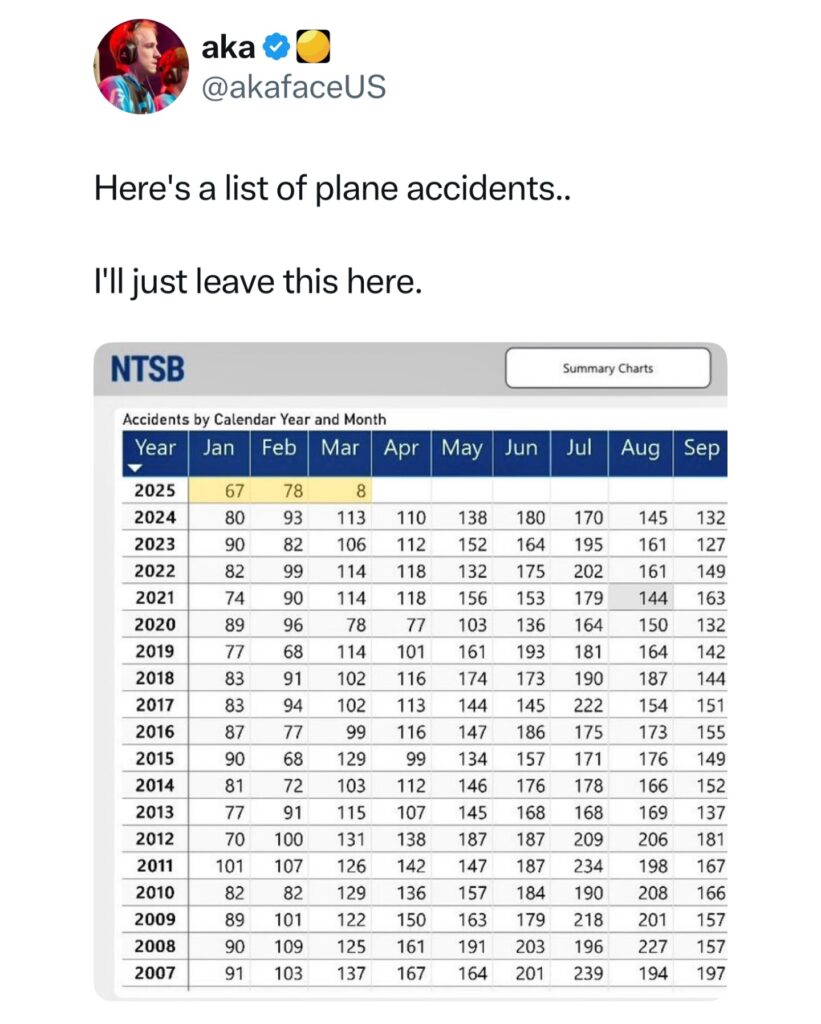
The Plane Accident Chart That’s Got Everyone Talking: A Closer Look at the Viral NTSB Post
In the age of digital attention spans and viral visuals, one image can ignite a thousand interpretations. This week, a tweet from user @akafaceUS lit up social media with a cryptic yet provocative post: a chart from the National Transportation Safety Board (NTSB) detailing aviation accidents by month and year — paired with the caption, “Here’s a list of plane accidents… I’ll just leave this here.”
The implication? Something odd — maybe even sinister — is happening with aviation data in 2025.
What the Chart Shows
The chart lists monthly plane accident totals across multiple years, from 2007 to 2025. For each year, the number of incidents per month is documented — January through September. While most years have robust data with high accident numbers across months, what immediately stands out is the 2025 row: January and February show somewhat normal figures (67 and 78, respectively), but March? A baffling 8.
That’s not a typo. In a dataset where March usually sees anywhere from 90 to 137 accidents, the number 8 stands out like a red flag.
Why People Are Buzzing
In the world of Twitter (now known as X), such a visual is gold. It’s short, punchy, and seems to suggest a conspiracy or at least a shocking anomaly. Some viewers interpret the drop as evidence of:
- A massive underreporting or data suppression effort
- A technological breakthrough in aviation safety
- A glitch in the reporting systems
- A government cover-up
- Or even something darker and more conspiratorial
The vagueness of the tweet — “I’ll just leave this here” — only adds fuel. It implies the image speaks for itself. And in a world where people often believe what they want to believe, it has sparked a range of interpretations.
But what’s actually going on here?
The Likely Explanation: Incomplete Data
Before jumping to conclusions, the most straightforward and likely explanation is this: the 2025 data is incomplete.
As of now (April 2025), we are only partway through the year. It’s possible, even probable, that the NTSB has not yet finalized or published the full March data. NTSB reports often undergo verification and auditing, which means totals can lag weeks or months behind. That would explain why January and February are filled in, but March (and beyond) show abnormally low numbers — or are blank altogether.
This kind of data lag is common in public datasets, especially those related to investigations, fatalities, and complex transport incidents. A delay in reporting is not evidence of foul play; it’s often just bureaucracy doing what bureaucracy does: moving slowly.
Data Without Context: A Modern Problem
This viral moment is another example of a growing issue: charts without context.
It’s incredibly easy to pull a chart from a credible source, post it with minimal commentary, and let the internet run wild. The problem is, even credible data can mislead if timing and completeness aren’t clear.
To the average viewer, the drop from 78 to 8 in one month seems outrageous — and maybe it is. But with no accompanying explanation, it encourages speculation rather than insight. And that’s dangerous, particularly when it involves something as sensitive and anxiety-inducing as aviation safety.
The Power of Implication
This tweet is a masterclass in how implication works in digital discourse.
By saying nothing — literally just “I’ll leave this here” — the user leaves the interpretation up to the crowd. And because people are primed to be suspicious (of government, media, corporations, etc.), many assume the worst.
It’s a form of weaponized ambiguity, and it’s becoming increasingly popular. It’s also a smart way to go viral: you’re not responsible for what people read into the post, but you still get credit for the insight (or outrage) it sparks.
Should We Be Worried About 2025 Aviation Safety?
Let’s be clear: the number “8” in March 2025 is weird. Even if the data is incomplete, it underscores the need for transparency in public-facing reports. If the NTSB had included a simple footnote — “Data for March 2025 is provisional and may change” — the firestorm might’ve been avoided.
But without that context, viewers are left to connect dots with crayons.
That said, there’s no credible evidence (as of now) suggesting that aviation safety is suddenly deteriorating, or that data is being suppressed for nefarious reasons. In fact, U.S. aviation has long been among the safest modes of transportation, with accident rates consistently trending downward over the decades.
The real issue may be public trust — or the lack thereof. When agencies fail to clearly communicate, people fill in the gaps. Often with conspiracy, not caution.
How Social Media Fuels the Fire
This episode also highlights how social media shapes public perception.
A single post with a suspicious-looking stat can go viral in minutes, spawning conspiracy theories, political takes, and even mainstream media coverage — all before anyone verifies the basic facts. It’s infotainment, driven by emotion, not investigation.
And once the narrative has formed — “they’re hiding something,” “aviation is falling apart,” “the government is lying” — it’s almost impossible to reel it back in. Even if the NTSB later updates the numbers and shows March had a normal accident rate, that tweet will have already left its mark.
The Bigger Picture: Critical Thinking in the Age of Viral Data
If there’s one lesson to take from this viral post, it’s this: data doesn’t speak for itself — interpretation does.
A chart can be accurate but misleading. A number can be technically correct but misrepresent the truth. And context — always — is king.
Before hitting the share button, before jumping into comment wars, it’s worth asking:
- Is this data complete?
- What’s the source?
- What’s the timing?
- Could there be a simpler explanation?
Because in a world drowning in information, skepticism without cynicism might be the most important skill of all.
Final Thought
The tweet featuring the NTSB chart is a perfect case study in the modern information ecosystem. It’s viral, vague, visually compelling — and potentially misleading. Whether it was posted in good faith or not, the reaction reveals something deeper about how we consume data and form opinions.
In a time when everyone is both a broadcaster and a fact-checker, it’s never been more important to read between the lines — and to wait before leaping to conclusions. Because sometimes, that shocking stat is just a placeholder for information that hasn’t arrived yet.
And sometimes… it’s just March.






